University Finance Assignment: Ratio Analysis of The Langham Hotel
VerifiedAdded on 2023/06/03
|18
|3873
|304
Report
AI Summary
This report presents a comprehensive ratio analysis of The Langham Hotel, focusing on its financial performance from 2015 to 2017. The analysis covers key financial ratios, including liquidity (current ratio, quick ratio, accounts receivable turnover), solvency (debt to equity ratio, interest cover, total liabilities/total assets), and profitability (net margin, ROA, ROE). The study reveals a decreasing trend in liquidity ratios, indicating challenges in meeting short-term obligations. Solvency ratios highlight an increasing debt burden and potential financial risk. Profitability ratios demonstrate a decline in net margin, ROA, and ROE, reflecting issues with sales and overall profitability. The report recommends strategies to improve financial health, such as increasing hotel service portfolios, optimizing existing hotel performance, and managing debt to enhance solvency and profitability.
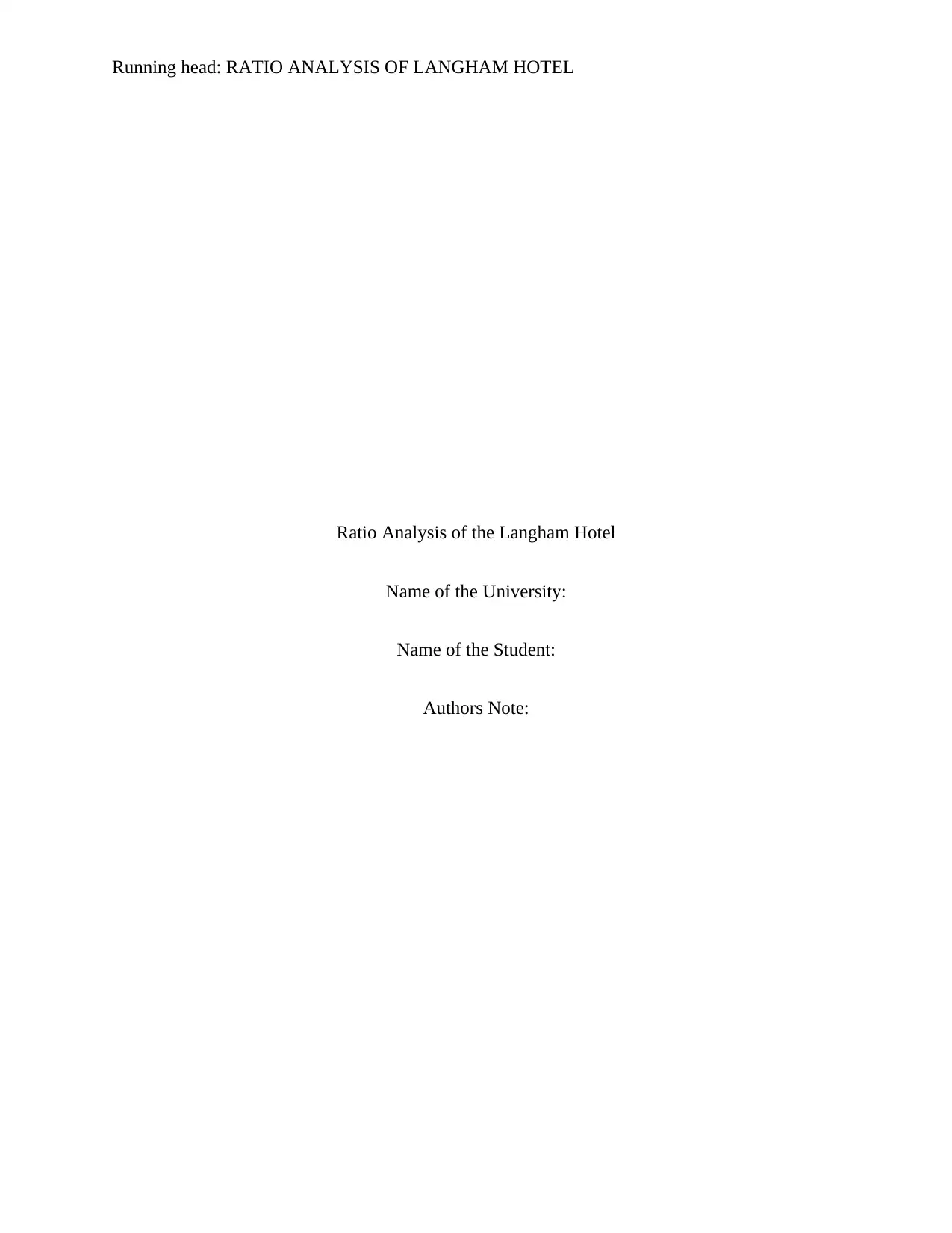
Running head: RATIO ANALYSIS OF LANGHAM HOTEL
Ratio Analysis of the Langham Hotel
Name of the University:
Name of the Student:
Authors Note:
Ratio Analysis of the Langham Hotel
Name of the University:
Name of the Student:
Authors Note:
Paraphrase This Document
Need a fresh take? Get an instant paraphrase of this document with our AI Paraphraser

1RATIO ANALYSIS OF LANGHAM HOTEL
Executive Summary
Langam is positioned as a renowned hospitality and restaurant company all over Australia that
owns and invests in a portfolio of hotels with a primary focus on other restaurant joints in
Australia. The paper considered analyzing the financial position of the company based on the
ratio analysis focused on which suitable recommendation will be provided. It was gathered from
the paper that there has been decrease in the occupancy rate within the hotel and the average
room rate has been increased by the hotel over the three years. This is the reason for which
Langam hotel is being efficient enough in paying for all its liabilities by using its assets.
Moreover, The Langam hotel is not being able to address its short-term obligations through
employing its highly liquid assets. To deal with such concern, the Langam Hotel is
recommended to increasing the hotel services portfolio in all its business locations along with
developing strategies of increasing its banqueting business.
Executive Summary
Langam is positioned as a renowned hospitality and restaurant company all over Australia that
owns and invests in a portfolio of hotels with a primary focus on other restaurant joints in
Australia. The paper considered analyzing the financial position of the company based on the
ratio analysis focused on which suitable recommendation will be provided. It was gathered from
the paper that there has been decrease in the occupancy rate within the hotel and the average
room rate has been increased by the hotel over the three years. This is the reason for which
Langam hotel is being efficient enough in paying for all its liabilities by using its assets.
Moreover, The Langam hotel is not being able to address its short-term obligations through
employing its highly liquid assets. To deal with such concern, the Langam Hotel is
recommended to increasing the hotel services portfolio in all its business locations along with
developing strategies of increasing its banqueting business.

2RATIO ANALYSIS OF LANGHAM HOTEL
Table of Contents
1. Introduction......................................................................................................................3
2. Horizontal Ratio Analysis................................................................................................3
2.1. Liquidity Ratio Analysis...........................................................................................3
2.2. Solvency Ratio Analysis...........................................................................................7
2.3. Profitability Ratio Analysis....................................................................................10
3. Conclusion.....................................................................................................................14
References..........................................................................................................................15
Table of Contents
1. Introduction......................................................................................................................3
2. Horizontal Ratio Analysis................................................................................................3
2.1. Liquidity Ratio Analysis...........................................................................................3
2.2. Solvency Ratio Analysis...........................................................................................7
2.3. Profitability Ratio Analysis....................................................................................10
3. Conclusion.....................................................................................................................14
References..........................................................................................................................15
⊘ This is a preview!⊘
Do you want full access?
Subscribe today to unlock all pages.

Trusted by 1+ million students worldwide

3RATIO ANALYSIS OF LANGHAM HOTEL
1. Introduction
Ratio analysis facilitates in carrying out financial analysis of an organization that
facilitates in determining the sustainable position of the company in the industry (Amran &
Aripin, 2015). The objective of the paper is to analyze the ratio analysis of The Langam Hotel of
Australia. Langam is positioned as a renowned hospitality and restaurant company all over
Australia that owns and invests in a portfolio of hotels with a primary focus on other restaurant
joints in Australia. All the hotels of the company are observed to be located in vibrant leisure and
commercial places in Australia and Hong Kong. Moreover, the horizontal trend analysis of the
selected ratios such as liquidity, solvency and profitability ratios are carried out in order to
evaluate financial risk, capital structure and profitability (Arkan, 2016).Moreover, the paper will
also consider analyzing the financial position of the company based on the ratio analysis focused
on which suitable recommendation will be provided.
2. Horizontal Ratio Analysis
2.1. Liquidity Ratio Analysis
2015 2016 2017
RATIO ANALYSIS
Liquidity
Current Ratio 0.21 0.12 0.09
Quick Ratio 0.15 0.05 0.05
Accounts Receivable Turnover (times) 3.29 0.96 2.46
1. Introduction
Ratio analysis facilitates in carrying out financial analysis of an organization that
facilitates in determining the sustainable position of the company in the industry (Amran &
Aripin, 2015). The objective of the paper is to analyze the ratio analysis of The Langam Hotel of
Australia. Langam is positioned as a renowned hospitality and restaurant company all over
Australia that owns and invests in a portfolio of hotels with a primary focus on other restaurant
joints in Australia. All the hotels of the company are observed to be located in vibrant leisure and
commercial places in Australia and Hong Kong. Moreover, the horizontal trend analysis of the
selected ratios such as liquidity, solvency and profitability ratios are carried out in order to
evaluate financial risk, capital structure and profitability (Arkan, 2016).Moreover, the paper will
also consider analyzing the financial position of the company based on the ratio analysis focused
on which suitable recommendation will be provided.
2. Horizontal Ratio Analysis
2.1. Liquidity Ratio Analysis
2015 2016 2017
RATIO ANALYSIS
Liquidity
Current Ratio 0.21 0.12 0.09
Quick Ratio 0.15 0.05 0.05
Accounts Receivable Turnover (times) 3.29 0.96 2.46
Paraphrase This Document
Need a fresh take? Get an instant paraphrase of this document with our AI Paraphraser
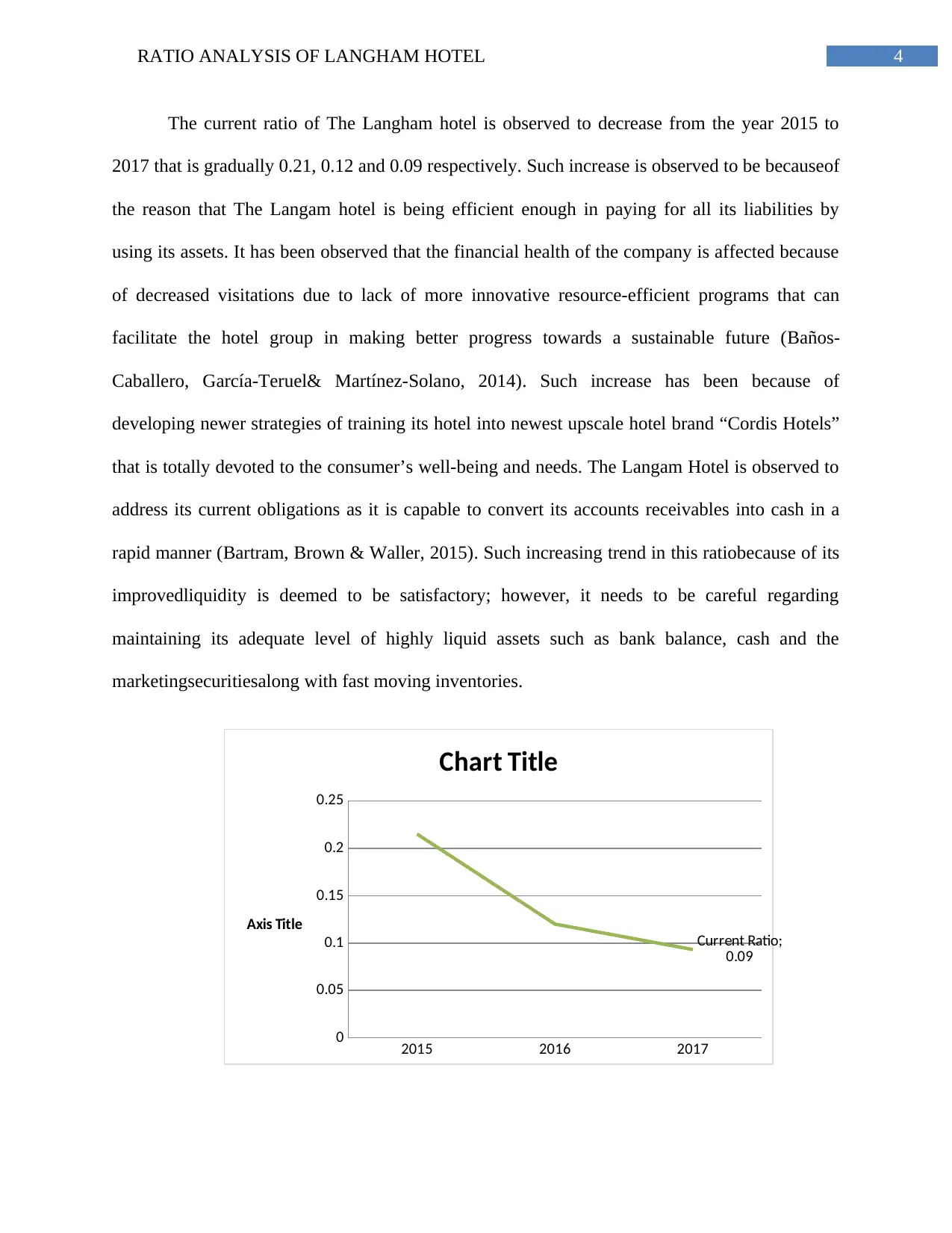
4RATIO ANALYSIS OF LANGHAM HOTEL
The current ratio of The Langham hotel is observed to decrease from the year 2015 to
2017 that is gradually 0.21, 0.12 and 0.09 respectively. Such increase is observed to be becauseof
the reason that The Langam hotel is being efficient enough in paying for all its liabilities by
using its assets. It has been observed that the financial health of the company is affected because
of decreased visitations due to lack of more innovative resource-efficient programs that can
facilitate the hotel group in making better progress towards a sustainable future (Baños-
Caballero, García-Teruel& Martínez-Solano, 2014). Such increase has been because of
developing newer strategies of training its hotel into newest upscale hotel brand “Cordis Hotels”
that is totally devoted to the consumer’s well-being and needs. The Langam Hotel is observed to
address its current obligations as it is capable to convert its accounts receivables into cash in a
rapid manner (Bartram, Brown & Waller, 2015). Such increasing trend in this ratiobecause of its
improvedliquidity is deemed to be satisfactory; however, it needs to be careful regarding
maintaining its adequate level of highly liquid assets such as bank balance, cash and the
marketingsecuritiesalong with fast moving inventories.
2015 2016 2017
0
0.05
0.1
0.15
0.2
0.25
Current Ratio;
0.09
Chart Title
Axis Title
The current ratio of The Langham hotel is observed to decrease from the year 2015 to
2017 that is gradually 0.21, 0.12 and 0.09 respectively. Such increase is observed to be becauseof
the reason that The Langam hotel is being efficient enough in paying for all its liabilities by
using its assets. It has been observed that the financial health of the company is affected because
of decreased visitations due to lack of more innovative resource-efficient programs that can
facilitate the hotel group in making better progress towards a sustainable future (Baños-
Caballero, García-Teruel& Martínez-Solano, 2014). Such increase has been because of
developing newer strategies of training its hotel into newest upscale hotel brand “Cordis Hotels”
that is totally devoted to the consumer’s well-being and needs. The Langam Hotel is observed to
address its current obligations as it is capable to convert its accounts receivables into cash in a
rapid manner (Bartram, Brown & Waller, 2015). Such increasing trend in this ratiobecause of its
improvedliquidity is deemed to be satisfactory; however, it needs to be careful regarding
maintaining its adequate level of highly liquid assets such as bank balance, cash and the
marketingsecuritiesalong with fast moving inventories.
2015 2016 2017
0
0.05
0.1
0.15
0.2
0.25
Current Ratio;
0.09
Chart Title
Axis Title
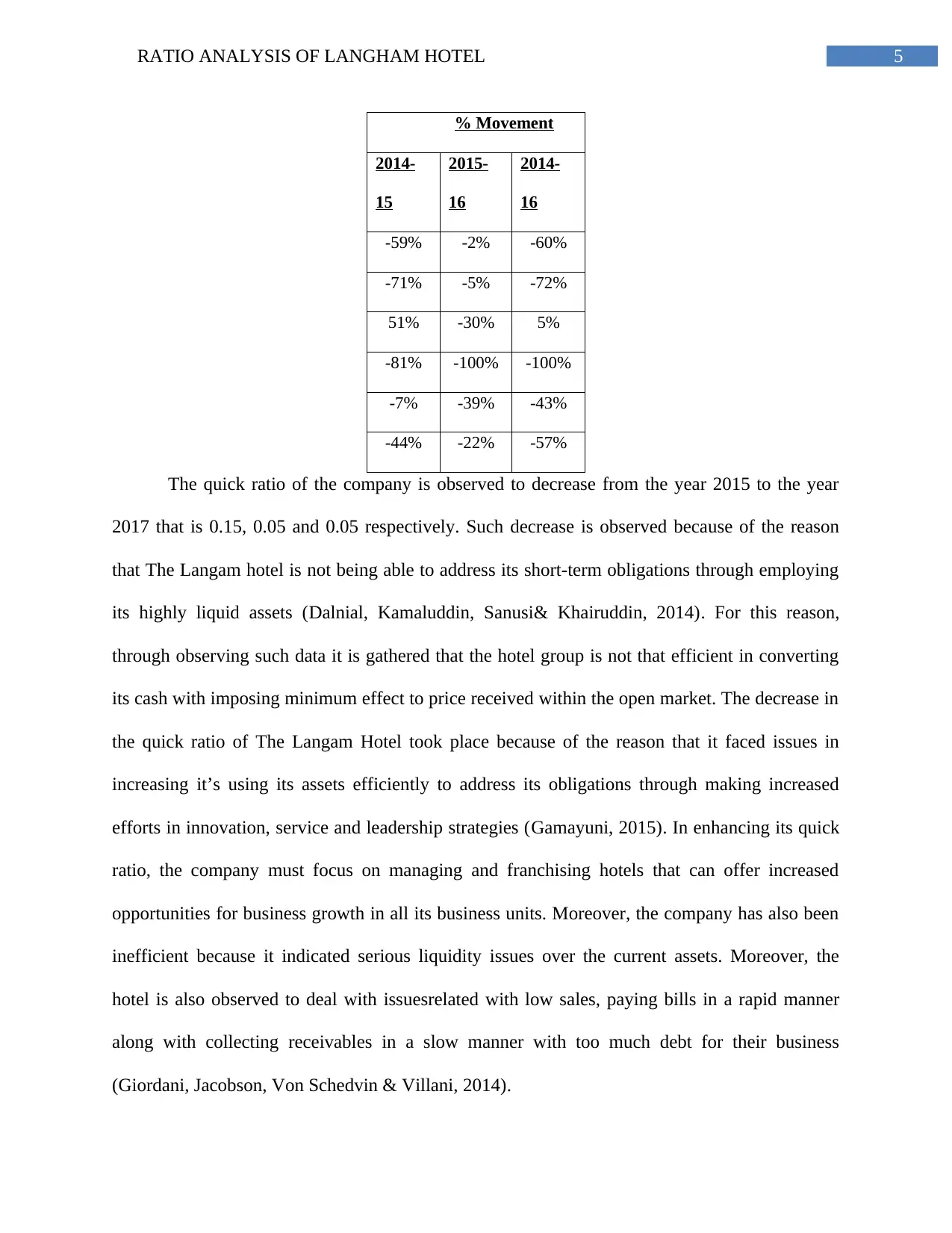
5RATIO ANALYSIS OF LANGHAM HOTEL
% Movement
2014-
15
2015-
16
2014-
16
-59% -2% -60%
-71% -5% -72%
51% -30% 5%
-81% -100% -100%
-7% -39% -43%
-44% -22% -57%
The quick ratio of the company is observed to decrease from the year 2015 to the year
2017 that is 0.15, 0.05 and 0.05 respectively. Such decrease is observed because of the reason
that The Langam hotel is not being able to address its short-term obligations through employing
its highly liquid assets (Dalnial, Kamaluddin, Sanusi& Khairuddin, 2014). For this reason,
through observing such data it is gathered that the hotel group is not that efficient in converting
its cash with imposing minimum effect to price received within the open market. The decrease in
the quick ratio of The Langam Hotel took place because of the reason that it faced issues in
increasing it’s using its assets efficiently to address its obligations through making increased
efforts in innovation, service and leadership strategies (Gamayuni, 2015). In enhancing its quick
ratio, the company must focus on managing and franchising hotels that can offer increased
opportunities for business growth in all its business units. Moreover, the company has also been
inefficient because it indicated serious liquidity issues over the current assets. Moreover, the
hotel is also observed to deal with issuesrelated with low sales, paying bills in a rapid manner
along with collecting receivables in a slow manner with too much debt for their business
(Giordani, Jacobson, Von Schedvin & Villani, 2014).
% Movement
2014-
15
2015-
16
2014-
16
-59% -2% -60%
-71% -5% -72%
51% -30% 5%
-81% -100% -100%
-7% -39% -43%
-44% -22% -57%
The quick ratio of the company is observed to decrease from the year 2015 to the year
2017 that is 0.15, 0.05 and 0.05 respectively. Such decrease is observed because of the reason
that The Langam hotel is not being able to address its short-term obligations through employing
its highly liquid assets (Dalnial, Kamaluddin, Sanusi& Khairuddin, 2014). For this reason,
through observing such data it is gathered that the hotel group is not that efficient in converting
its cash with imposing minimum effect to price received within the open market. The decrease in
the quick ratio of The Langam Hotel took place because of the reason that it faced issues in
increasing it’s using its assets efficiently to address its obligations through making increased
efforts in innovation, service and leadership strategies (Gamayuni, 2015). In enhancing its quick
ratio, the company must focus on managing and franchising hotels that can offer increased
opportunities for business growth in all its business units. Moreover, the company has also been
inefficient because it indicated serious liquidity issues over the current assets. Moreover, the
hotel is also observed to deal with issuesrelated with low sales, paying bills in a rapid manner
along with collecting receivables in a slow manner with too much debt for their business
(Giordani, Jacobson, Von Schedvin & Villani, 2014).
⊘ This is a preview!⊘
Do you want full access?
Subscribe today to unlock all pages.

Trusted by 1+ million students worldwide
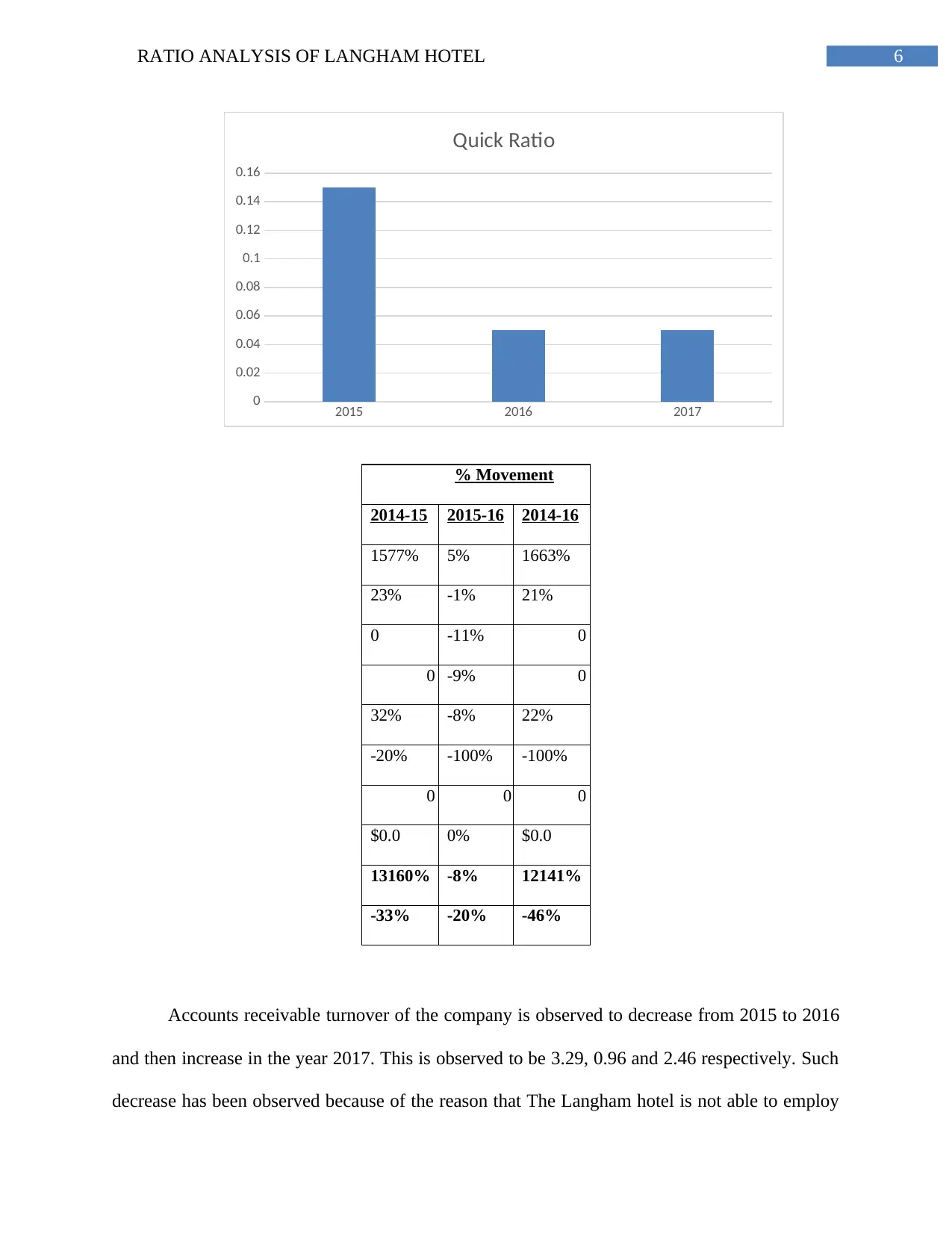
6RATIO ANALYSIS OF LANGHAM HOTEL
2015 2016 2017
0
0.02
0.04
0.06
0.08
0.1
0.12
0.14
0.16
Quick Ratio
% Movement
2014-15 2015-16 2014-16
1577% 5% 1663%
23% -1% 21%
0 -11% 0
0 -9% 0
32% -8% 22%
-20% -100% -100%
0 0 0
$0.0 0% $0.0
13160% -8% 12141%
-33% -20% -46%
Accounts receivable turnover of the company is observed to decrease from 2015 to 2016
and then increase in the year 2017. This is observed to be 3.29, 0.96 and 2.46 respectively. Such
decrease has been observed because of the reason that The Langham hotel is not able to employ
2015 2016 2017
0
0.02
0.04
0.06
0.08
0.1
0.12
0.14
0.16
Quick Ratio
% Movement
2014-15 2015-16 2014-16
1577% 5% 1663%
23% -1% 21%
0 -11% 0
0 -9% 0
32% -8% 22%
-20% -100% -100%
0 0 0
$0.0 0% $0.0
13160% -8% 12141%
-33% -20% -46%
Accounts receivable turnover of the company is observed to decrease from 2015 to 2016
and then increase in the year 2017. This is observed to be 3.29, 0.96 and 2.46 respectively. Such
decrease has been observed because of the reason that The Langham hotel is not able to employ
Paraphrase This Document
Need a fresh take? Get an instant paraphrase of this document with our AI Paraphraser
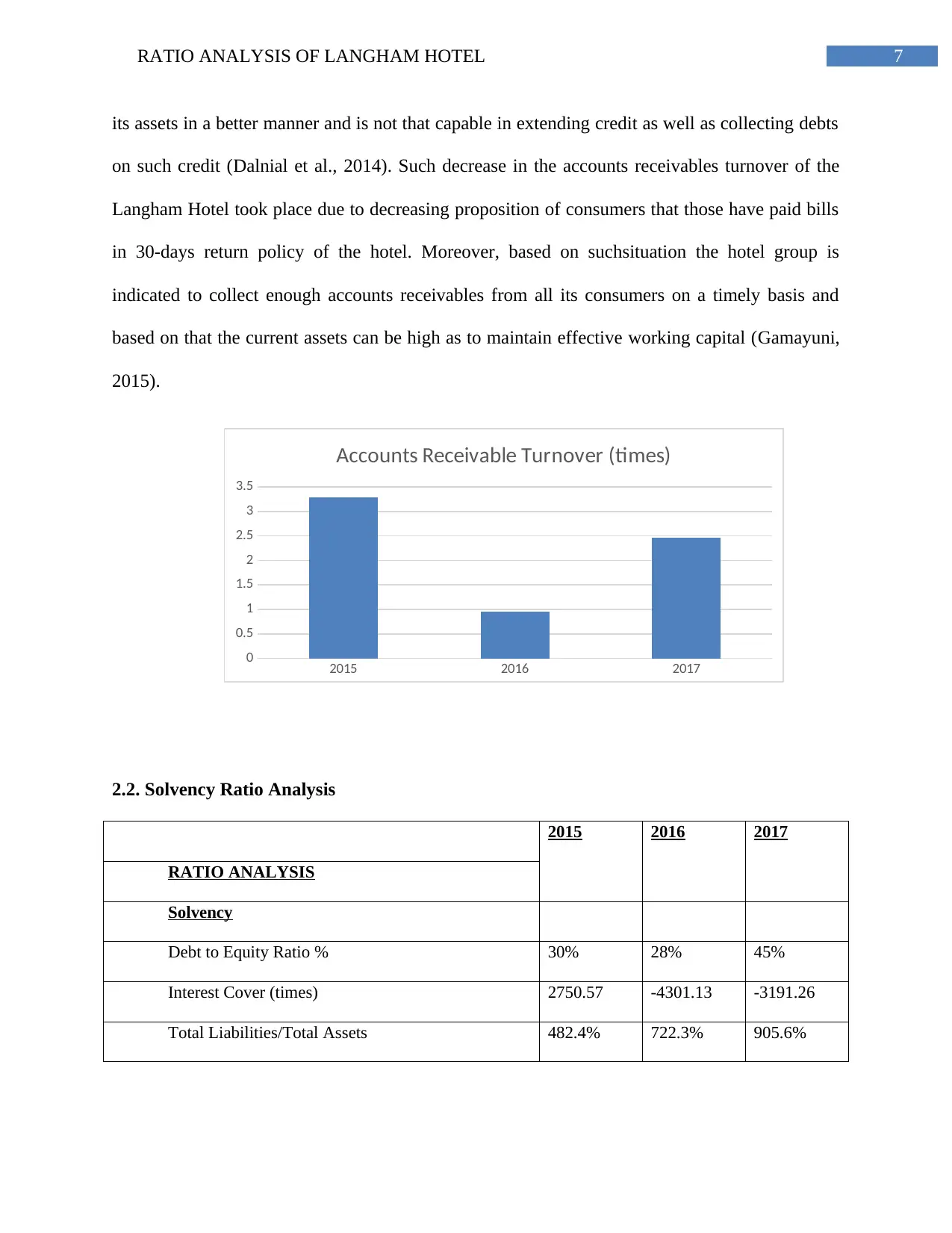
7RATIO ANALYSIS OF LANGHAM HOTEL
its assets in a better manner and is not that capable in extending credit as well as collecting debts
on such credit (Dalnial et al., 2014). Such decrease in the accounts receivables turnover of the
Langham Hotel took place due to decreasing proposition of consumers that those have paid bills
in 30-days return policy of the hotel. Moreover, based on suchsituation the hotel group is
indicated to collect enough accounts receivables from all its consumers on a timely basis and
based on that the current assets can be high as to maintain effective working capital (Gamayuni,
2015).
2015 2016 2017
0
0.5
1
1.5
2
2.5
3
3.5
Accounts Receivable Turnover (times)
2.2. Solvency Ratio Analysis
2015 2016 2017
RATIO ANALYSIS
Solvency
Debt to Equity Ratio % 30% 28% 45%
Interest Cover (times) 2750.57 -4301.13 -3191.26
Total Liabilities/Total Assets 482.4% 722.3% 905.6%
its assets in a better manner and is not that capable in extending credit as well as collecting debts
on such credit (Dalnial et al., 2014). Such decrease in the accounts receivables turnover of the
Langham Hotel took place due to decreasing proposition of consumers that those have paid bills
in 30-days return policy of the hotel. Moreover, based on suchsituation the hotel group is
indicated to collect enough accounts receivables from all its consumers on a timely basis and
based on that the current assets can be high as to maintain effective working capital (Gamayuni,
2015).
2015 2016 2017
0
0.5
1
1.5
2
2.5
3
3.5
Accounts Receivable Turnover (times)
2.2. Solvency Ratio Analysis
2015 2016 2017
RATIO ANALYSIS
Solvency
Debt to Equity Ratio % 30% 28% 45%
Interest Cover (times) 2750.57 -4301.13 -3191.26
Total Liabilities/Total Assets 482.4% 722.3% 905.6%
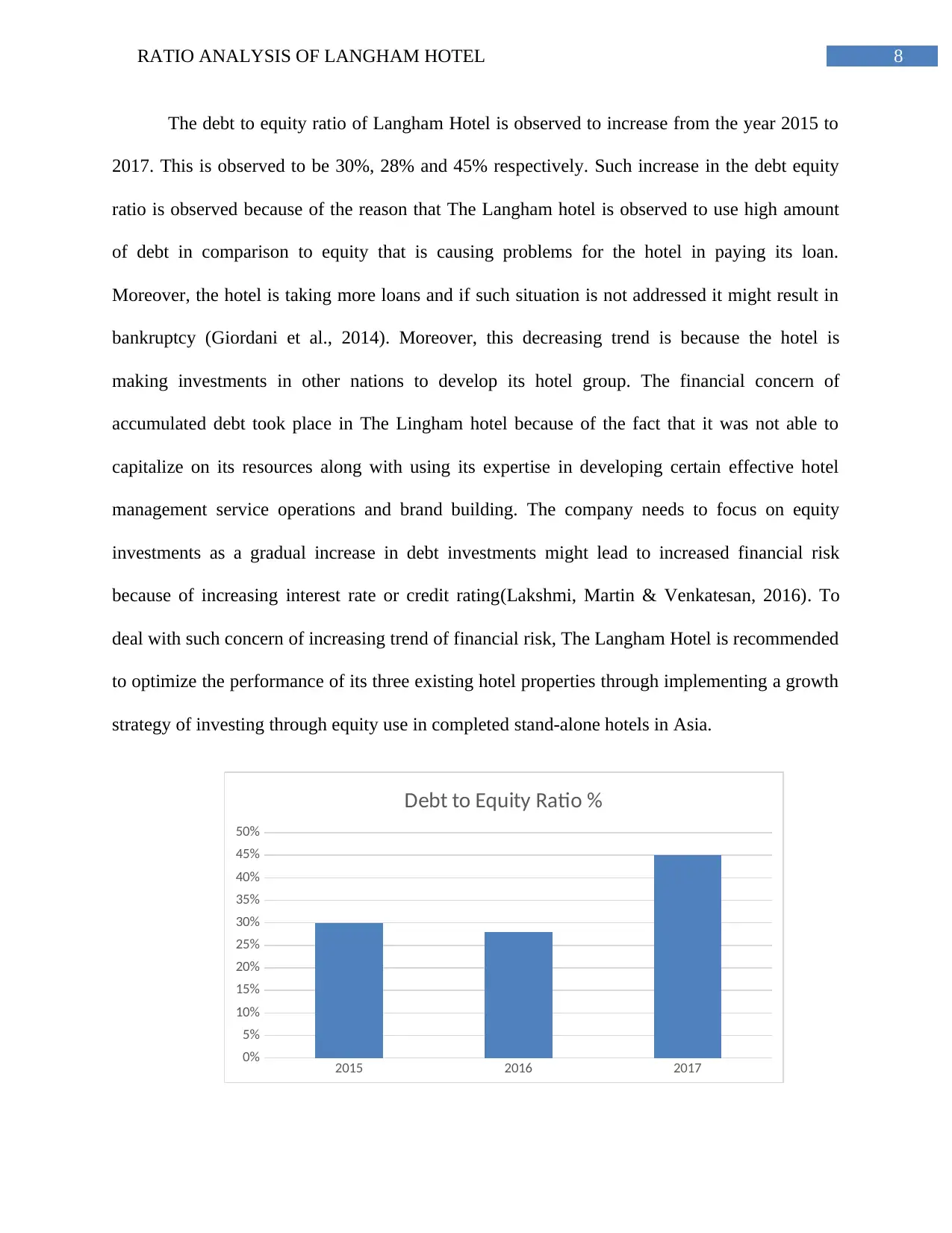
8RATIO ANALYSIS OF LANGHAM HOTEL
The debt to equity ratio of Langham Hotel is observed to increase from the year 2015 to
2017. This is observed to be 30%, 28% and 45% respectively. Such increase in the debt equity
ratio is observed because of the reason that The Langham hotel is observed to use high amount
of debt in comparison to equity that is causing problems for the hotel in paying its loan.
Moreover, the hotel is taking more loans and if such situation is not addressed it might result in
bankruptcy (Giordani et al., 2014). Moreover, this decreasing trend is because the hotel is
making investments in other nations to develop its hotel group. The financial concern of
accumulated debt took place in The Lingham hotel because of the fact that it was not able to
capitalize on its resources along with using its expertise in developing certain effective hotel
management service operations and brand building. The company needs to focus on equity
investments as a gradual increase in debt investments might lead to increased financial risk
because of increasing interest rate or credit rating(Lakshmi, Martin & Venkatesan, 2016). To
deal with such concern of increasing trend of financial risk, The Langham Hotel is recommended
to optimize the performance of its three existing hotel properties through implementing a growth
strategy of investing through equity use in completed stand-alone hotels in Asia.
2015 2016 2017
0%
5%
10%
15%
20%
25%
30%
35%
40%
45%
50%
Debt to Equity Ratio %
The debt to equity ratio of Langham Hotel is observed to increase from the year 2015 to
2017. This is observed to be 30%, 28% and 45% respectively. Such increase in the debt equity
ratio is observed because of the reason that The Langham hotel is observed to use high amount
of debt in comparison to equity that is causing problems for the hotel in paying its loan.
Moreover, the hotel is taking more loans and if such situation is not addressed it might result in
bankruptcy (Giordani et al., 2014). Moreover, this decreasing trend is because the hotel is
making investments in other nations to develop its hotel group. The financial concern of
accumulated debt took place in The Lingham hotel because of the fact that it was not able to
capitalize on its resources along with using its expertise in developing certain effective hotel
management service operations and brand building. The company needs to focus on equity
investments as a gradual increase in debt investments might lead to increased financial risk
because of increasing interest rate or credit rating(Lakshmi, Martin & Venkatesan, 2016). To
deal with such concern of increasing trend of financial risk, The Langham Hotel is recommended
to optimize the performance of its three existing hotel properties through implementing a growth
strategy of investing through equity use in completed stand-alone hotels in Asia.
2015 2016 2017
0%
5%
10%
15%
20%
25%
30%
35%
40%
45%
50%
Debt to Equity Ratio %
⊘ This is a preview!⊘
Do you want full access?
Subscribe today to unlock all pages.

Trusted by 1+ million students worldwide

9RATIO ANALYSIS OF LANGHAM HOTEL
The interest cover ratio of Langham Hotel is observed to decrease from the year 2015 to
2017. This is observed to be 2750.57, -4301.13 and -3191.26 respectively. Such decrease in this
ratio is observed because of the reason that The Langham Hotel has been dealing with issue of
increased debt burden that might increasing the possibility of bankruptcy
(Langhamhospitality.com., 2018). This also indicates that the hotel group is not able to address
its interest obligations to maintain its solvency. In addition in the situation of this company it is
observed that the risk of default is deemed to be high as the lenders will refuse to lend the hotel
observing its ability to pay its interest expenses. To deal with such situation the Langam Hotel is
recommended to consider decreasing its expenses in purchasing raw material for its restaurant.
This can be done through negotiating and revising contrasts with its food suppliers (Liang et al.,
2016). The company is also recommended to increase its term of loan that candecrease the term
of investments to be paid each year. This can facilitate in enhancing its debt position along with
increasing the interest cover ratio. Moreover, the hotel must also consider developing budgeted
sums of furniture’s, fixtures along with equipment categories for renovation investments in all its
hotels that can reduce its overall business expenses (Liang, Tsai & Shih, 2016).
2015 2016 2017
-5000
-4000
-3000
-2000
-1000
0
1000
2000
3000
4000
Interest Cover (times)
The interest cover ratio of Langham Hotel is observed to decrease from the year 2015 to
2017. This is observed to be 2750.57, -4301.13 and -3191.26 respectively. Such decrease in this
ratio is observed because of the reason that The Langham Hotel has been dealing with issue of
increased debt burden that might increasing the possibility of bankruptcy
(Langhamhospitality.com., 2018). This also indicates that the hotel group is not able to address
its interest obligations to maintain its solvency. In addition in the situation of this company it is
observed that the risk of default is deemed to be high as the lenders will refuse to lend the hotel
observing its ability to pay its interest expenses. To deal with such situation the Langam Hotel is
recommended to consider decreasing its expenses in purchasing raw material for its restaurant.
This can be done through negotiating and revising contrasts with its food suppliers (Liang et al.,
2016). The company is also recommended to increase its term of loan that candecrease the term
of investments to be paid each year. This can facilitate in enhancing its debt position along with
increasing the interest cover ratio. Moreover, the hotel must also consider developing budgeted
sums of furniture’s, fixtures along with equipment categories for renovation investments in all its
hotels that can reduce its overall business expenses (Liang, Tsai & Shih, 2016).
2015 2016 2017
-5000
-4000
-3000
-2000
-1000
0
1000
2000
3000
4000
Interest Cover (times)
Paraphrase This Document
Need a fresh take? Get an instant paraphrase of this document with our AI Paraphraser

10RATIO ANALYSIS OF LANGHAM HOTEL
The total liabilities/ total assets ratio of Langham Hotel is observed to decrease from the
year 2015 to 2017. This is observed to be 482.4%, 722.3% and 905.6% respectively. Such
decreasing horizontal trend is observed in case of the Langham Hotel because of the reason that
the hotel is not that efficient in using its assets to address all its liabilities in a timely manner
(Omar et al., 2014). The hotel has an increased leverage degree due to investors and creditors
might not prefer being associated with the hotel group because of its increased leverage. The
Langam Hotel is observed to deal with the risk of increasing liabilities in paying off its liabilities
and it also has a decreased profit percentage in principal and interest payments. To deal with
such situation, the hotel group is recommended to finance most of its business expansion
activities through equity and decreasing availability of its risky assets (Prentice, 2016).
2015 2016 2017
0.00%
100.00%
200.00%
300.00%
400.00%
500.00%
600.00%
700.00%
800.00%
900.00%
1000.00%
Total Liabilities/Total Assets
2.3. Profitability Ratio Analysis
2015 2016 2017
RATIO ANALYSIS
Profitability
Net Margin % 25.39% -146.17% -83.87%
The total liabilities/ total assets ratio of Langham Hotel is observed to decrease from the
year 2015 to 2017. This is observed to be 482.4%, 722.3% and 905.6% respectively. Such
decreasing horizontal trend is observed in case of the Langham Hotel because of the reason that
the hotel is not that efficient in using its assets to address all its liabilities in a timely manner
(Omar et al., 2014). The hotel has an increased leverage degree due to investors and creditors
might not prefer being associated with the hotel group because of its increased leverage. The
Langam Hotel is observed to deal with the risk of increasing liabilities in paying off its liabilities
and it also has a decreased profit percentage in principal and interest payments. To deal with
such situation, the hotel group is recommended to finance most of its business expansion
activities through equity and decreasing availability of its risky assets (Prentice, 2016).
2015 2016 2017
0.00%
100.00%
200.00%
300.00%
400.00%
500.00%
600.00%
700.00%
800.00%
900.00%
1000.00%
Total Liabilities/Total Assets
2.3. Profitability Ratio Analysis
2015 2016 2017
RATIO ANALYSIS
Profitability
Net Margin % 25.39% -146.17% -83.87%

11RATIO ANALYSIS OF LANGHAM HOTEL
ROA % 23.7% -30.8% -27.7%
ROE % 1% -2% -1%
The net margin ratio of Langham Hotel is observed to decrease from the year 2015 to
2017. This is observed to be 25.39%, -146.17% and -83.87% respectively. Such decreasing
horizontal trend in this ratio is caused because of the reason that it is not being able to attain
enough sales in order to attain a high net income (Rakicevic, Milosevic, Petrovic &
Radojevic,2014). There has been decrease in the occupancy rate within the hotel and the average
room rate has been increased by the hotel over the three years. The hotel group has also
considered including the hotel management and license fees along with enhancing the hotel
portfolio performance of its company. This took place due to the reason that the hotel group is
experiencing low return on assets along with fulfilling all its obligations (Sarlin, 2015). To deal
with such concern, the Langam Hotel is recommended to increasing the hotel services portfolio
in all its business locations along with developing strategies of increasing its banqueting
business. Moreover, to increase its net margin Langham Hotels must also consider increasing its
demand for renovated rooms that can capture more travelers from all over the world (Schmidgall
& DeFranco, 2016).
ROA % 23.7% -30.8% -27.7%
ROE % 1% -2% -1%
The net margin ratio of Langham Hotel is observed to decrease from the year 2015 to
2017. This is observed to be 25.39%, -146.17% and -83.87% respectively. Such decreasing
horizontal trend in this ratio is caused because of the reason that it is not being able to attain
enough sales in order to attain a high net income (Rakicevic, Milosevic, Petrovic &
Radojevic,2014). There has been decrease in the occupancy rate within the hotel and the average
room rate has been increased by the hotel over the three years. The hotel group has also
considered including the hotel management and license fees along with enhancing the hotel
portfolio performance of its company. This took place due to the reason that the hotel group is
experiencing low return on assets along with fulfilling all its obligations (Sarlin, 2015). To deal
with such concern, the Langam Hotel is recommended to increasing the hotel services portfolio
in all its business locations along with developing strategies of increasing its banqueting
business. Moreover, to increase its net margin Langham Hotels must also consider increasing its
demand for renovated rooms that can capture more travelers from all over the world (Schmidgall
& DeFranco, 2016).
⊘ This is a preview!⊘
Do you want full access?
Subscribe today to unlock all pages.

Trusted by 1+ million students worldwide
1 out of 18
Related Documents
Your All-in-One AI-Powered Toolkit for Academic Success.
+13062052269
info@desklib.com
Available 24*7 on WhatsApp / Email
![[object Object]](/_next/static/media/star-bottom.7253800d.svg)
Unlock your academic potential
Copyright © 2020–2025 A2Z Services. All Rights Reserved. Developed and managed by ZUCOL.





